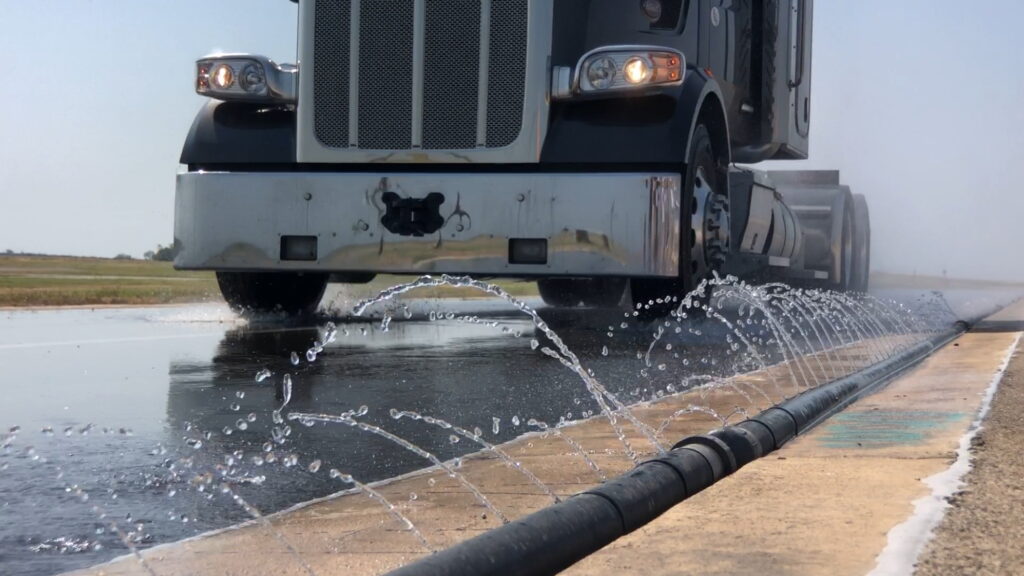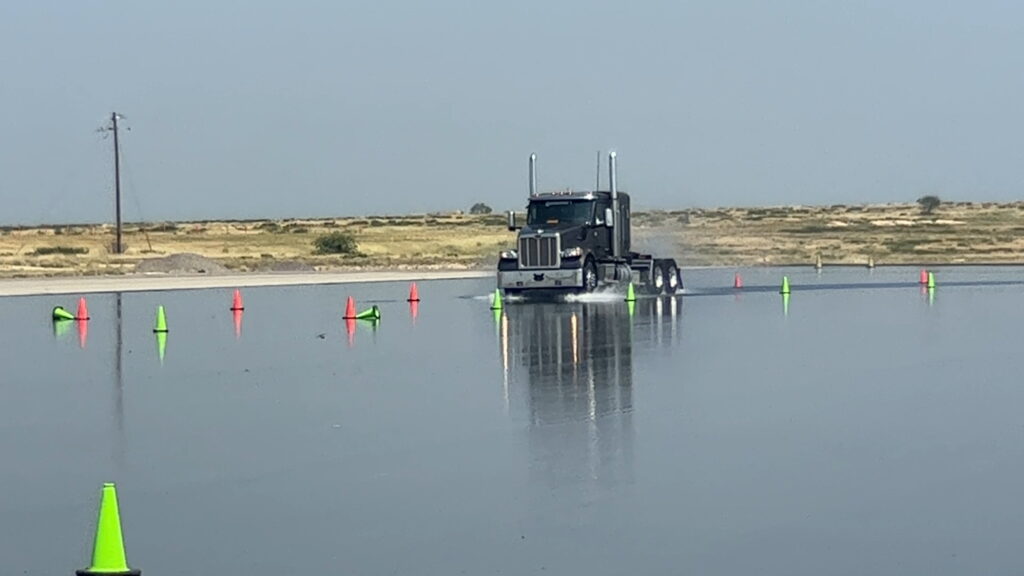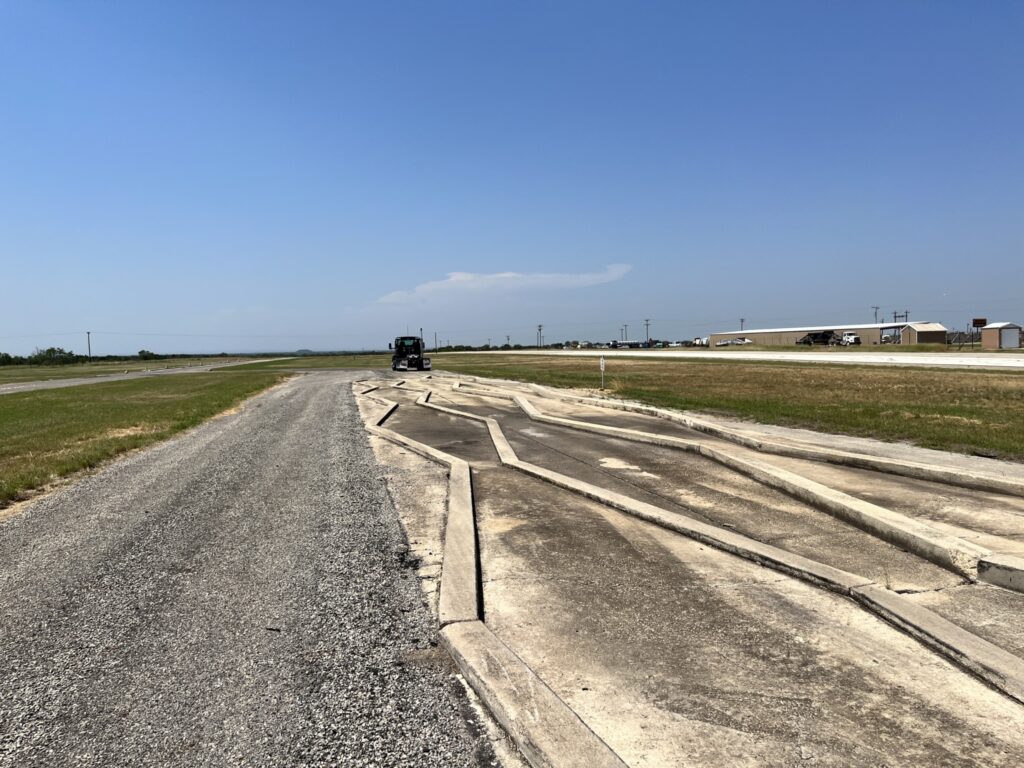Continental Tire’s Uvalde proving grounds test tires, Texas style
Tires are now the third- or fourth-highest expense for most fleets, yet they are still treated as commodities. They are way more than “round and black.” The engineering and testing that goes into top-tier tires is quite amazing, but most tire consumers never consider all that. Tire selection often comes down to price, which is really not the best selection criteria.
Unfortunately, most tire consumers never get the chance to watch tire engineering in action. Recently, Continental Tire invited a group of truck journalists to tour the company’s proving ground complex in Uvalde, Texas.

Called ContiExperience, the event offered reporters, dealers, and select fleet customers hands-on demonstrations of several tire testing and evaluation experiences, as well as a comprehensive tour of the proving grounds.
Uvalde Proving Grounds (UPG), home to Continental Tire Research & Development North America, occupies nearly 5,000 acres, located about 12 km (8 miles) south of Uvalde, Texas, which sits about 135 km (85 miles) west of San Antonio. The facility can test and evaluate any type of tire, from passenger car and light truck tires to medium- and heavy-duty trucks, right up to gigantic earth-mover tires.
The hot, dry climate allows for year-round testing under comparable conditions. Up to 20 or 30 testing programs may be underway at the site on any given day. Continental rents access to the site to various OEMs, research companies and others. Each year, testers and researchers log about 3.3 million miles (5.3 million km) at the site, or about 70,000 hours of testing time, and burn through about 20,000 tires.

Uvalde Proving Grounds
The facility was built by General Tire in 1959 beginning with an 8.7-mile (14 km) oval circuit designed to evaluate passenger car tires. The track allowed cars to be driven without interruption at speeds higher than would have been possible using public highways. This approach produced highly reproduceable and comparable results.
Additional tracks were constructed in the 1980s as tire producers responded to changing consumer expectations. In addition to mileage, performance, and damage resistance, tire safety characteristics were gaining consumer interest. By the mid-‘80s, the facility had a variety of tracks and test surfaces duplicating everything from interstate highways to downtown streets.
Continental acquired General Tire in 1987, and with the acquisition came the proving grounds.
At the time, American car drivers and automobile manufacturers were concentrating on the value of tire performance and breakdown-resistance on rough road surfaces. Continental, with its European roots, shifted that focus to handling and safety — reducing stopping distances, and avoiding aquaplaning, to name a few areas. That adjustment in priority saw the development of more safety-related testing facilities, including aquaplaning pools, dry handling courses, and wet grip surfaces.
To increase efficiency and safety of tire endurance testing, in 2018, Continental engineers developed a driverless test vehicle that could run around the track until it exhausted its fuel supply. Automation, and the ability to control vehicles with exceptional precision, not only improved the test results, it optimized track use and reduced wear and tear. It also made the testing much safer. Human drivers no longer have to pilot trucks for hundreds of hours over the monotonous course.
Today, the Uvalde Proving Grounds boasts about 26 paved and off-road courses, and 400 test vehicles including heavy equipment, tractors, passenger cars, light trucks, commercial vehicles, motorcycles, and trailers. It’s also home to more than 6,000 sq.-ft. of shop and private office space as well as secured bays that are available to non-tire automotive-related testing groups.

Wet Traction Testing
While Continental couldn’t possibly tour a bunch of journalists around to every test site at the facility, we did visit the Wet Handling Track. It’s an 800×800-foot, 15-acre asphalt pad (the largest in North America) designed to exacting specifications.
While it appears flat and level, it has a 1% grade across the entire surface that allows water from a perforated pipe at the top of the pad to flow in controllable depths (from .05 to .11 inches) over the surface. The run-off is collected and funneled back into underground storage tanks for later use. Water is drawn from an underground well, and extensively recycled for use at other wet testing areas.
Because of its size, the pad is well-suited for wet traction testing while maneuvering at speed. Cars and trucks can easily get up to highway speed before attempting a maneuver, such as accelerating or braking in a turn or on a long sweeping curve, serpentine maneuvers, or even jackknife maneuvers.
We had the opportunity to drive a bobtail Peterbilt Model 567 sleeper tractor through a long sweeping curve with a full ABS stop. The truck had Conti Ecoplus HS3+ 295/75R22.5 steer tires and ContiTread HDL 3 LTL-R retread drive tires. I pushed through diminishing radius curve at between 40 and 50 mph (60-80 kmh) and never broke traction — which was mildly surprising for a bobtail tractor with little weight to hold the tires to the track. In the full-application ABS stop, the truck tracked straight down the line. It was a pretty impressive demonstration of the traction provided by those tires.
There was also a straight wet track where Continental tests wet stopping distance. With a thin layer of water flowing across the track, the truck gets up to 50 mph (80 kmh) and makes a full ABS stop, which is triggered remotely for measurement purposes. In comparisons reported by Continental, the above-mentioned retreaded drive tires achieved a shorter stopping distance than a competitor’s budget virgin tire — the same type of tire often chosen by fleets in lieu of retreaded tires.
The retreaded tires managed to stop in 57.175 meters (187.6 feet), while the competitor’s new tire went 57.625 (189.05 feet), or about two feet further. That’s not a lot, but it demonstrates that particular tread pattern and compound is as good as or even slightly better than that particular new tire.
“The biggest obstacle our sales team has to overcome is getting fleets to have confidence in retreaded tires,” said Continental’s product marketing manager, Bridney Jordan, explaining the significance of the test. “Fleets will tell us they don’t believe in retreading, using refurbished tires, etc. That couldn’t be further from the truth. We proved right here that the Conti retread stopped in a shorter distance than that brand new tire.”
When doing actual wet traction testing, they run each test seven times, and drop the shortest and longest run and average the five remaining runs.

Dry handling test
While the Dry Handling test doesn’t apply to heavy trucks, it did demonstrate how tread compounds, casing design and tread design contribute to traction and handling.
The track, build in 2015, is a 1.07-mile asphalt-surfaced road course featuring a 1,200-foot straightaway, curves, turns, and bends of 50 feet to 500 feet. Tires are tested for dry handling performance to evaluate varying designs and constructions. Vehicle construction and suspension evaluations are also conducted on this course.
Reporters drove two laps of the course in each of two cars: a four-cylinder turbocharged Ford Mustang equipped with General Tire G-Max RS tires, and a V-6 Dodge Challenger fitted with Conti ExtremeContact Sport 02 tires.
During actual testing and evaluations, the vehicles are well instrumented, but the reporter’s test drivers were, well, pretty subjective at best. I came away thinking I could get about an additional 10 mph from the Challenger with Conti’s ExtremeContact Sport tires, still feeling very confident in the road handling at speeds approaching 70 mph.
Curbing test
The final heavy truck test we saw was the curbing test, where tires are driven over and off curbs to test the tread and sidewall’s resistance to tearing, chipping and scrub damage. The demonstration we saw featured a bobtail tractor, so the tires weren’t badly stressed. Normally the trucks are fully loaded. It was obvious from the strips of rubber laying alongside the curb that more than a few tires had given their lives in the quest for more durable treads and sidewalls.
Specialty tests
There were nine different courses designed to test tires’ resistance to damage from rough and rocky surfaces. Using various types of rock, stone and gravel laid over hard and soft surfaces, trucks would run for a predetermined number of laps evaluate cutting and shipping of the tread by the gravel overlay.
One course was a circular bed filled with pea gravel. Trucks would run through the gravel and then onto a hard paved surface to test the tires’ ability to eject stones from between the treads. Or, to determine the extent to which stones that were not successfully ejected drilled into the casing.
Some of the off-road courses were absolutely brutal, with rocks measuring in sizes from golf balls to soft balls, soft sand, and a section of track with embedded telephone poles. There were grades up to 33% and surfaces ranging from smooth concrete to gravel-covered dirt. Engineers use these obstacles to evaluate traction as well as susceptibility to tread damage.
Digital tire monitoring
Continental also showcased its digital tire monitoring offering, ContiConnect. The system uses proprietary sensors inside tires to track inflation pressure, casing temperature, and mileage among other metrics. Collected data is transmitted to the ContiConnect web portal.
Over-the-road fleets can opt for the ContiConnect Live solution, where the data is transmitted in real time from the truck to the web portal via the fleet’s onboard telematics unit. This solution provides GPS asset tracking to improve fuel efficiency, extend tire life, and reduce labor costs associated with manual tire inspections. Continental says it can also be used to detect missing/stolen tires.
Local and regional fleets that return to base regularly might prefer the in-yard option, ContiConnect Yard. Vehicles drive past a reader station in the yard, where data is collected and relayed to the ContiConnect platform. Instant notifications allow any tire issues to be addressed while the truck is in the yard. Tire inspections and fleet checks can be performed without touching the tire, the company says.
Continental is currently developing a smartphone-based tire scanning app that will use the camera to make a 3-D image of the tire capable of measuring tread depth. Trey Thompson, Continental’s field engineering manager, said the app is based on the same technology used in facial recognition.
“All you have to do is walk up and take a photo of the tire and [the app] will connect with the tire’s internal sensors” he said.
Data from the sensors coupled with the 3-D image is uploaded to the ContiConnect platform and becomes instantly readable by anyone subscribed to the service.
Thompson did not provide details on when the app would be available.
So, while price will always be a consideration when buying tires, it’s useful to consider what goes into the tire before you mount in on the truck. A cheap tire may seem like a bargain at the time, but if it’s life expectancy or resistance to damage is half that of a top-tier tire, is it really that good a deal?
Have your say
This is a moderated forum. Comments will no longer be published unless they are accompanied by a first and last name and a verifiable email address. (Today's Trucking will not publish or share the email address.) Profane language and content deemed to be libelous, racist, or threatening in nature will not be published under any circumstances.
Does Uvalde Proving Grounds able to contact the original testing company named General Tire Testing and is it possible for General Tire Testing to provide employee W-2 forms for an employee from years 1980 to 1983?